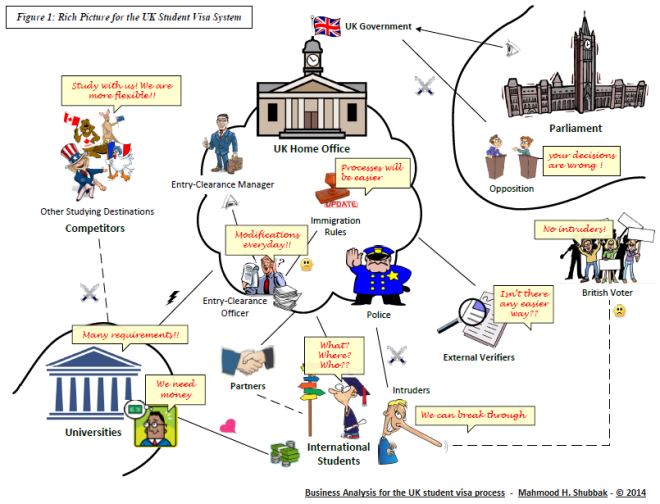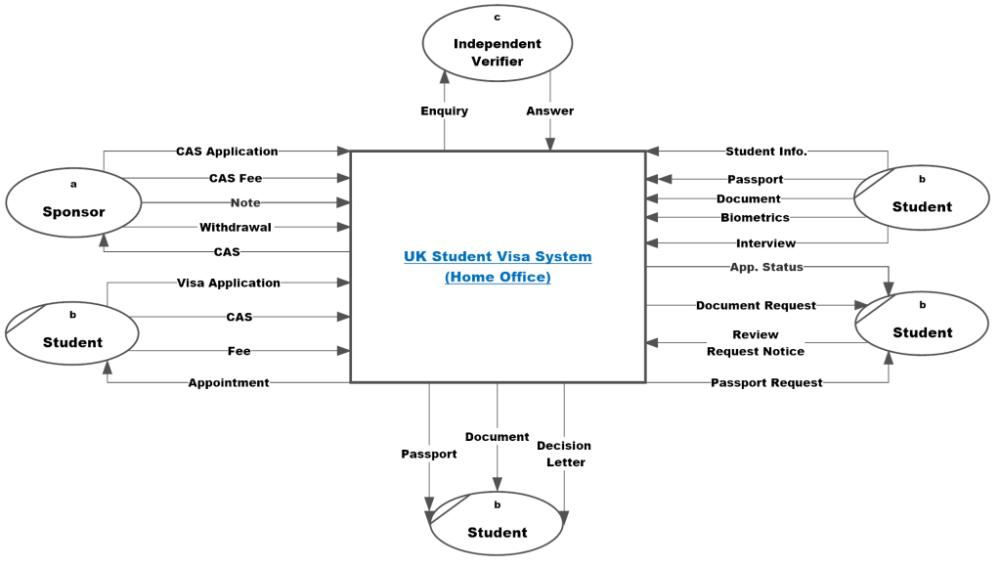Introduction
As a division of the United Kingdom Home Office – the equivalent to the ministry of interior in many countries -, UK Visas and Immigration UKVI is the government agency responsible for issuing and managing entry visas and residence permits in the UK. Britain is considered as one of the most attractive destinations for students from all over the world (UCAS, 2013). According to statistics from the UK Council for International Students Affairs, non-UK students formed about 13% of all undergraduate degree students in the British universities, and 47% of all postgraduates in 2013 (UKCISA, 2014b). International Students, who are not from one of the European Economic Area (EEA) countries or Switzerland, may need visa to study in the United Kingdom, depending on their nationalities and the length of their intended studies. In this paper, a business analysis investigation of the UK student visa process is carried out, in order to understand it, sort its sub-processes and procedures in a systematic representation, and try to figure out its inadequacies. To do so, a general study of the UK immigration rules, guidance documents, application procedures, national framework of qualifications, some related cases, and news articles were initially done, followed by a specific determination of the investigation scope, as well as an explanation of the chosen business analysis tools and techniques.  As stated in the UK immigration rules, short courses of no longer than six months are considered as ‘study visits’, which for ‘low risk’ nationalities; Argentina, Australia, Barbados, Botswana, Brunei, Canada, Chile, Hong Kong, Japan, Malaysia, New Zealand, Singapore, South Korea, Trinidad and Tobago, USA, and recently, since 6th April 2014, Oman, UAE and Qatar, do not require visa, while for the other nationalities, it requires students to apply for ‘student visitor’ visa (UKCISA, 2014a). For longer studies, international students are required to apply for Tier 4 visa under the points based visa system. Tier 4 (General) student visa is for 16 years or older applicants, and Tier 4 (Child) student visa for children between 4 and 17 years old. Moreover, under some conditions, students’ family members – partners and children – might be able to join and stay with them during their studies in the UK, by applying for Tier 4 dependant visa. Applications can be done by the student himself or by a registered representative. Moreover, they can either be made from outside the UK for what is called ‘entry clearance’, or from inside the UK to extend the current visa which is called ‘leave to remain’. Students who are outside the UK must apply online, except for Cuba and North Korea where students have to fill paper application forms (GOV.UK, 2014b).
As stated in the UK immigration rules, short courses of no longer than six months are considered as ‘study visits’, which for ‘low risk’ nationalities; Argentina, Australia, Barbados, Botswana, Brunei, Canada, Chile, Hong Kong, Japan, Malaysia, New Zealand, Singapore, South Korea, Trinidad and Tobago, USA, and recently, since 6th April 2014, Oman, UAE and Qatar, do not require visa, while for the other nationalities, it requires students to apply for ‘student visitor’ visa (UKCISA, 2014a). For longer studies, international students are required to apply for Tier 4 visa under the points based visa system. Tier 4 (General) student visa is for 16 years or older applicants, and Tier 4 (Child) student visa for children between 4 and 17 years old. Moreover, under some conditions, students’ family members – partners and children – might be able to join and stay with them during their studies in the UK, by applying for Tier 4 dependant visa. Applications can be done by the student himself or by a registered representative. Moreover, they can either be made from outside the UK for what is called ‘entry clearance’, or from inside the UK to extend the current visa which is called ‘leave to remain’. Students who are outside the UK must apply online, except for Cuba and North Korea where students have to fill paper application forms (GOV.UK, 2014b). To make the analysis more specific, and since international students are following generally the same procedure when applying for a long term student visa – except some ‘Differentiation Arrangements’ for the ‘low risk’ nationalities who need less supporting documents -, the scope of investigation in this report will be limited to the Tier 4 (General) entry clearance application processes, from the point of being admitted to an educational institute, making an online visa application, up to getting the application outcome. This means that the visitor, Tier 4 (Child), and dependant visas as well as the attendance monitoring and reports post-visa granting are out of the investigation scope. However, it is worth mentioning that for the other two visa types; child student and dependant, a very similar procedure is followed, but with some additional requirements and supporting documents.
To make the analysis more specific, and since international students are following generally the same procedure when applying for a long term student visa – except some ‘Differentiation Arrangements’ for the ‘low risk’ nationalities who need less supporting documents -, the scope of investigation in this report will be limited to the Tier 4 (General) entry clearance application processes, from the point of being admitted to an educational institute, making an online visa application, up to getting the application outcome. This means that the visitor, Tier 4 (Child), and dependant visas as well as the attendance monitoring and reports post-visa granting are out of the investigation scope. However, it is worth mentioning that for the other two visa types; child student and dependant, a very similar procedure is followed, but with some additional requirements and supporting documents.
Table of Contents
Introduction
Business Analysis Techniques
Information Sources
CASE Tools
The Scenario
Socio-Technical Approach
Rich Picture
Stakeholder Analysis
Engineering Approach
Managing CAS
Visa Application
Visa-Centre Appointment
Application Processing
Making Decision
Administrative Review
Applying SSADM
Comments and Observations
Main Risks
Comparison with the German System
Inadequacies and Recommended Solutions
Other Inadequacies beyond Investigation Scope
Post-Analysis Evaluation
Bibliography
Appendix A: Process Description
Appendix B: External Entity Description
Appendix C: I/O Description
Appendix D: Document Examination Report DER Sample
Appendix E: Document Verification Report DVR Template
Figures
Figure 1: Rich Picture for the UK Student Visa System
Figure 2: extended power/interest grid
Figure 3: Level 0 Data Flow Diagram
Figure 4: Level 1 Data Flow Diagram
Figure 5: Level 2 DFD – Process 1
Figure 6: Level 2 DFD – Process 3
Figure 7: Level 2 DFD – Process 4
Figure 8: Level 3 DFD – Process 4.1
Figure 9: Level 3 DFD – Process 4.3
Figure 10: Entity Relationship Model ERM
Figure 11: Entity Life History- CAS
Figure 12: Entity Life History – Document
Figure 13: Entity Life History – VC Account
Figure 14: Entity Life History – Online Application
Figure 15: Entity Life History – Submitted Application
Tables
Table 1: Structured Methods Sample – Process Description 4.3.4
Table 2: Entity-Event Matrix
The full business analysis report can be provided upon request.
